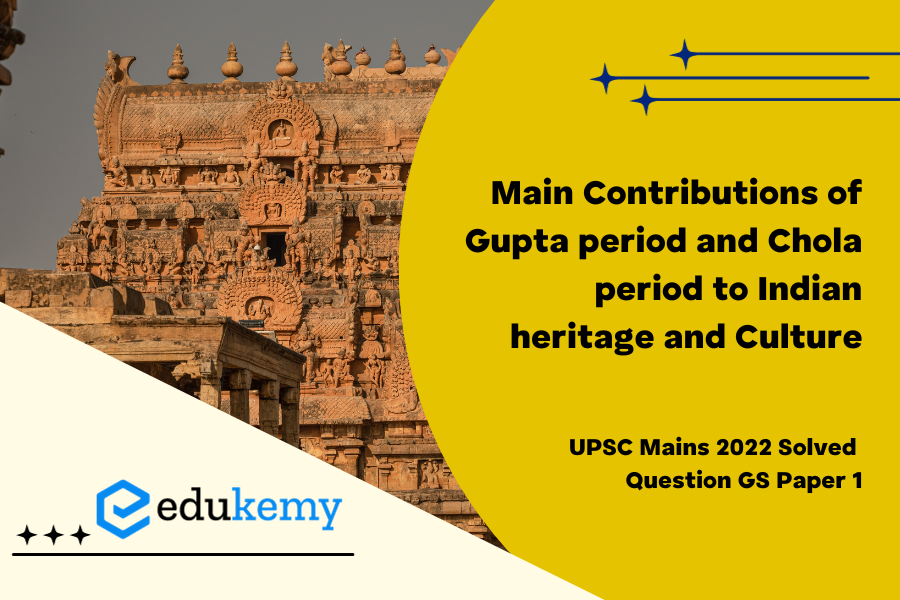The Gupta period, known as the “Golden Age” of India, contributed to Indian heritage through advancements in science, mathematics, and arts, exemplified by the creation of the concept of zero and the flourishing of classical Sanskrit literature. The Chola period left a lasting legacy with its temple architecture, maritime trade, and administrative innovations, which significantly influenced South Indian culture and societal structures.
UPSC Mains General Studies Paper – 1 Mains 2022
UPSC Mains Civil Services IAS Exam Question Paper – 2022
Contents
Approach
- Introducing the Gupta period and Chola period’s significance with the timeline of Indian History .
- Comprehensively discuss with prime contributions of Gupta as the “Golden Age” and Chola rulers exquisite temple architecture, to Indian heritage and culture.
- Accordingly conclude it .
Answer
Introduction
The Gupta period (320 CE-550 CE) and the Chola period (9th-13th century CE) are two of the most significant periods in Indian history, known for their contributions to Indian heritage and culture. Here are some of their main contributions:
Gupta Period
- Golden Age of Indian Culture: The Gupta period is often called the Golden Age of Indian Culture. It saw a flourishing of literature, science, art, and architecture, and the emergence of great scholars like Kalidas and Aryabhata.
Literature
- Sanskrit Literature: Sanskrit literature thrived during the Gupta era. The renowned playwright Kalidas composed masterpieces like “Abhijnanasakuntalam” and “Meghaduta.” These works are still celebrated for their poetic beauty and literary excellence.
- Aryabhata and Mathematics: The mathematician and astronomer Aryabhata made significant contributions to mathematics and astronomy during this period. His work “Aryabhata” provided insights into trigonometry and numerical calculations.
Art and Architecture
- Gupta Architecture: The Gupta rulers were great patrons of art and architecture. They built numerous temples and monuments adorned with intricate carvings and sculptures. The Gupta style of temple architecture is seen in temples like the Dashavatara Temple in Deogarh, Uttar Pradesh, featuring beautifully carved figures of Vishnu’s avatars.
- Buddhist Art: The Gupta period witnessed the creation of exquisite Buddhist sculptures and stupas, showcasing the development of Gandhari and Mathura schools of art. The Sarnath Lion Capital, now the national emblem of India, is a prominent example of Gupta art.
- Sculpture and Iconography: Gupta period sculptures are marked by a sense of idealism and naturalism. The Sarnath Lion Capital, now the national emblem of India, is an iconic sculpture from this period. It features four lions standing back to back, symbolizing the spread of Buddha’s teachings, and showcases the high level of skill and artistic expression of the Gupta sculptors.
- Educational and Cultural Centers: Universities and centers of learning flourished during the Gupta era. Nalanda and Taxila were famous educational institutions attracting scholars from across the world. These centers promoted the exchange of ideas and the spread of knowledge, making India a prominent center of learning.
- Religious Tolerance and Patronage: The Gupta rulers practiced religious tolerance and patronized various religions. Hinduism and Buddhism received significant support from the Gupta kings, leading to the construction of numerous temples and stupas, contributing to the rich religious and cultural heritage of India.
- Administrative Efficiency: The Gupta Empire implemented an efficient administrative system, promoting good governance and public welfare. The administration at both central and local levels was well-organized, contributing to the stability and prosperity of the empire, and providing a model for future administrations.
- Cultural Synthesis: The Gupta period witnessed a synthesis of diverse cultural influences, resulting in a vibrant and cosmopolitan society. This cultural fusion is evident in the art, architecture, and literature of the time, reflecting the rich diversity and inclusivity of the Gupta Empire.
- Mathematics and Science: The Gupta period is known for its contributions to mathematics and science, including Aryabhata by Aryabhata with the concept of zero, the decimal system, and the invention of the iron pillar.

Chola Period
- Maritime Trade: The Chola dynasty was a major maritime power in the Indian Ocean and played a crucial role in the growth of maritime trade and commerce. The Chola navy was one of the most powerful in the world at the time and their empire extended across much of South India and Southeast Asia.
- Temple Architecture: The Chola period is known for its exquisite temple architecture, including the Brihadeeswara Temple in Thanjavur (which is a UNESCO World Heritage Site), Rajarajeshwara temple, Gangaikonda Cholapuram temple took Dravidian architecture to newer heights. The epitome of the Dravid style of temple architecture.
- Literature and Education: The Chola period saw the emergence of many literary works in Tamil, including the Kamba Ramayana and the Tirukkural. Education and scholarship were highly valued, and many schools and universities were established.
- Administration and Governance: The Chola dynasty was known for its efficient administration and governance, The massive kingdom was divided into provinces which were known as mandalas. These were further divided into districts called nadus which consisted of tehsils. including a well-organized system of local self-government and a well-established judiciary system.
Conclusion
The Gupta period and the Chola period made significant contributions to Indian heritage and culture, including literature, science, art, architecture, maritime trade, temple architecture, education, administration, and governance.
In case you still have your doubts, contact us on 8792740517.
For UPSC Prelims Resources, Click here
For Daily Updates and Study Material:
Join our Telegram Channel – Edukemy for IAS
- 1. Learn through Videos – here
- 2. Be Exam Ready by Practicing Daily MCQs – here
- 3. Daily Newsletter – Get all your Current Affairs Covered – here
- 4. Mains Answer Writing Practice – here


